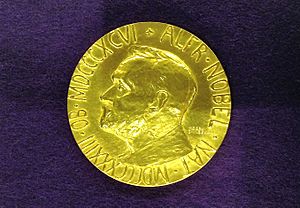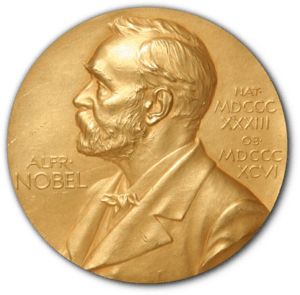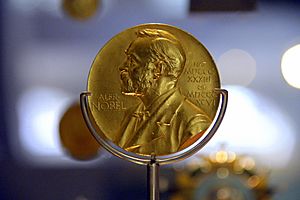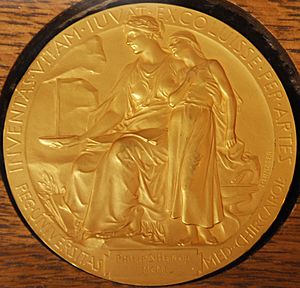Nobel Prize medal facts for kids
The Nobel Prize medal is a gold medal given to recipients of the Nobel Prizes of Chemistry, Literature, Peace, Physics and Physiology or Medicine since 1901. The medal for the Nobel Memorial Prize in Economic Sciences, given since 1968, is awarded with the aforementioned prizes.
Each medal has a portrait of Alfred Nobel in left profile on the obverse. The medals for chemistry, literature, physics, and physiology or medicine have an identical portrait of Nobel with different portraits on the peace and economics prize medals. The medals for chemistry, literature, physics, and physiology or medicine were designed by Erik Lindberg. The peace prize medal was designed by Gustav Vigeland, and the economics prize medal by Gunvor Svensson-Lundqvist.
The medals are struck in 18 carat green gold plated with 24 carat gold and weigh about 175 grams (0.386 lb) each, with the exception of the Economic prize medal which weighs 185g.
The recipients also receive a diploma that details their achievements, and a monetary award from the Nobel Foundation. The voting members of the Royal Swedish Academy of Sciences, the Nobel Assembly at the Karolinska Institute, and the Swedish Academy receive smaller replicas of the prize medals. The chemistry, literature, physics, physiology or medicine prizes are known as the 'Swedish medals'.
Contents
Design
Each medal has a portrait of Alfred Nobel in left profile on the obverse. The medals for Chemistry, Literature, Physics, and Physiology or Medicine have identical obverses, showing the image of Nobel and the years of his birth and death. Nobel's portrait also appears on the obverse of the Peace Prize medal and the Economics Prize medal, but with a slightly different portrait. The names of the chemistry, medicine, literature and physics prize recipients are engraved on the reverse of the medal on a small plate. The names of the peace and economic prize recipients are engraved on the edges of their medals. The Chemistry, Literature, Physics, and Physiology or Medicine medals were designed by Erik Lindberg. The Peace prize medal was designed by Gustav Vigeland, and the Economics prize medal by Gunvor Svensson-Lundqvist.
The inaugural Nobel laureates of 1901 received a 'temporary' medal that was struck in a lesser metal than gold. The first medals were eventually struck in September 1902. The delay was due to the designs needing to be approved by each respective awarding institution. The medals were designed by the sculptor Erik Lindberg.
Between 1902 and 2010 the Nobel Prize medals were struck by the Myntverket, the Swedish royal mint, located in Eskilstuna. In 2011 the medals were made by the Det Norske Myntverket in Kongsberg. The medals have been made by Svenska Medalj in Eskilstuna since 2012 with the exception of the peace prize medal which is made by the Det Norske Myntverket.
Physics and Chemistry
The medals for the Nobel Prizes in Physics and Chemistry are identical in design. They are given by the Royal Swedish Academy of Sciences. The reverse of the medal depicts the Goddess of Nature in the form of Isis as she emerges from clouds holding a cornucopia. The Genius of Science holds the veil which covers Nature's 'cold and austere face'. It was designed by Erik Lindberg and is manufactured by Svenska Medalj in Eskilstuna. It is inscribed "Inventas vitam iuvat excoluisse per artes" ("It is beneficial to have improved (human) life through discovered arts") an adaptation of "Inventas aut qui vitam excoluere per artes" from line 663 from book 6 of the Aeneid by the Roman poet Virgil. A plate below the figures is inscribed with the name of the recipient. The text "REG. ACAD. SCIENT. SUEC." denoting the Royal Swedish Academy of Sciences is inscribed on the reverse.
Physiology and Medicine
The medal for the Nobel Prize in Physiology or Medicine is given by the Nobel Assembly at the Karolinska Institute. The reverse of the medal depicts the 'Genius of Medicine holding an open book in her lap, collecting the water pouring out from a rock in order to quench a sick girl's thirst'. It is inscribed "Inventas vitam iuvat excoluisse per artes" ("It is beneficial to have improved (human) life through discovered arts") an adaptation of "inventas aut qui vitam excoluere per artes" from line 663 from book 6 of the Aeneid by the Roman poet Virgil. A plate below the figures is inscribed with the name of the recipient. The text "REG. UNIVERSITAS MED. CHIR. CAROL." denoting the Karolinska Institute is also inscribed on the reverse. It was designed by Erik Lindberg and is manufactured by Svenska Medalj in Eskilstuna.
Literature
The medal for the Nobel Prize in Literature is given by the Swedish Academy. The reverse of the medal depicts a ' ... young man sitting under a laurel tree who, enchanted, listens to and writes down the song of the Muse'. The 1923 recipient of the literature medal, W. B. Yeats wrote in his 1925 book The Bounty of Sweden that the medal was " ... charming, decorative, academic design, French in manner, a work of the nineties. It shows a young man listening to a Muse, who stands young and beautiful with a great lyre in her hand, and I think as I examine it, 'I was good-looking once like that young man, but my unpractised verse was full of infirmity, my Muse old as it were; and now I am old and rheumatic, and nothing to look at, but my Muse is young". It is inscribed "Inventas vitam iuvat excoluisse per artes" ("It is beneficial to have improved (human) life through discovered arts") an adaptation of "inventas aut qui vitam excoluere per artes" from line 663 from book 6 of the Aeneid by the Roman poet Virgil. A plate below the figures is inscribed with the name of the recipient. The text "ACAD. SUEC." denoting the Swedish Academy is also inscribed on the reverse. It was designed by Erik Lindberg and is manufactured by Svenska Medalj in Eskilstuna.
Peace

The medal for the Nobel Peace Prize was designed by the Norwegian sculptor Gustav Vigeland in 1901. Vigeland's profile sculpture of Alfred Nobel differs from Lindberg's. The dies for Vigeland's peace medal were made by Lindberg as Vigeland was not an engraver. The reverse of the medal features three men in a 'fraternal bond' and the inscription 'Pro pace et fraternitate gentium' ("For the peace and brotherhood of men"). The edge of the medal is inscribed with the year of its awarding, with the name of its recipient and "Prix Nobel de la Paix".
Economic Sciences
The medal for the Nobel Memorial Prize in Economic Sciences was designed by Gunvor Svensson-Lundqvist in 1968. The obverse of the medal depicts Alfred Nobel and the words "Sveriges Riksbank till Alfred Nobels Minne 1968" ("The Sveriges Riksbank, in memory of Alfred Nobel, 1968") with the symbol of the Sveriges Riksbank, the horn of plenty, displayed below. The name of the recipient is inscribed on the edge of the medal. The reverse features the emblem of the Royal Swedish Academy of Sciences, the North Star, in a design from 1815. "Kungliga Vetenskaps Akademien" ("The Royal Swedish Academy of Sciences") is inscribed around the edge of the star. It is the only medal without a quotation on its reverse. Since 2012 the economics medal has been manufactured by Svenska Medalj in Eskilstuna.
Composition
The medals are struck in 18 carat green gold plated with 24 carat gold. All medals made before 1980 were struck in 23 carat gold. The weight of each medal varies with the value of gold, but averages about 175 grams (0.386 lb) for each medal, with the exception of the Nobel Memorial Prize in Economic Sciences which weighs 185g. The diameter is 66 millimetres (2.6 in) and the thickness varies between 5.2 millimetres (0.20 in) and 2.4 millimetres (0.094 in).
During World War II, the medals of German scientists Max von Laue and James Franck were sent to Copenhagen for safekeeping. When Germany invaded Denmark, Hungarian chemist (and Nobel laureate himself) George de Hevesy dissolved them in aqua regia (nitro-hydrochloric acid), to prevent confiscation by Nazi Germany and to prevent legal problems for the holders. After the war, the gold was recovered from solution, and the medals re-cast.
List of thefts of medals
| Laureate | Image | Category and Year | Year of theft | Detail of theft | Status |
|---|---|---|---|---|---|
| Ernest Hemingway |  |
Literature, 1954 | 1986 | Hemingway donated his Nobel medal to the Catholic Church in Cuba, specifically to the Marian shrine of Our Lady of Charity at the Basílica Santuario Nacional de Nuestra Señora de la Caridad del Cobre. It was stolen in 1986. Raul Castro reportedly told the thieves 'Return the medal within 72 hours or face the consequences. I know who you are'. The medal was subsequently recovered. | Recovered. |
| Rabindranath Tagore |  |
Literature, 1913 | 2004 | Stolen in 2004 from a museum in West Bengal. In 2016, a local singer accused of sheltering the thieves was arrested, but the medal could not be recovered. Interrogation revealed that a Bangladeshi national, along with two Europeans, were involved in the theft. Two replicas, one in gold and one in silver were later presented to Viswa Bharati University by the Swedish government. Tagore's medal remained missing as of 2022, the Chief Minister of West Bengal, Mamata Banerjee, described the failure of police to find the medal as "big insult" for the people of Bengal. | Missing as of 2023 |
| Ernest O. Lawrence |  |
Physics, 1939 | 2007 | Stolen in 2007 from the E. O. Lawrence Memorial Room at the Lawrence Hall of Science at the University of California, Berkeley where it had been on display. It was recovered a few days later and a student working as a janitor at the hall was arrested. | Recovered, currently on display at the Lawrence Hall of Science at the University of California, Berkeley |
| Yasser Arafat |  |
Peace, 1994 | 2007 | Stolen in June 2007. | Unknown |
| Desmond Tutu |  |
Peace, 1984 | 2007 | Stolen in June 2007 from his home in Johannesburg and recovered a week later. | Recovered a week after theft. |
| Shirin Ebadi |  |
Peace, 2003 | 2009 | In October 2009 Ebadi's medal was taken from her bank box alongside her Légion d'honneur and a ring she had received from Germany's association of journalists. She said they had been taken by Iran's Revolutionary Court. Ebadi also said her bank account was frozen by authorities. The Norwegian Minister of Foreign Affairs Jonas Gahr Støre expressed his "shock and disbelief" at the incident. The Iranian foreign ministry subsequently denied the confiscation, and also criticized Norway for interfering in Iran's affairs. | Unknown |
| Arthur Henderson |  |
Peace, 1934 | 2013 | Stolen in a burglary of the office of the Lord Mayor of Newcastle on 3 April 2013. A man was subsequently jailed for the theft; the medal has never been recovered. | Unknown |
| Kailash Satyarthi |  |
Peace, 2014 | 2017 | Stolen in February 2017 and subsequently recovered. | Recovered |
| F. W. de Klerk |  |
Peace, 1993 | 2022 | Stolen from his home in November 2022. | Unknown |
List of sales of medals
| Laureate | Image | Category and Year | Year of Sale | Details | Price |
|---|---|---|---|---|---|
| Norman Angell |  |
Peace, 1933 | 1983 | Sold at auction at Sotheby's, London, in 1983. Now in the collection of the Imperial War Museum, London. | $12,000 (equivalent to $35,258 in 2022) |
| Niels Bohr |  |
Physics, 1922 | 1940 | Sold alongside the medal of 1920 physiology or medicine recipient August Krogh on 12 March 1940 to raise funds for the Fund for Finnish Relief (Finlandshjälpen) during World War II. Subsequently, donated to the Danish Historical Museum of Fredrikborg. | |
| Aage Bohr |  |
Physics, 1975 | 2019 | Sold at Heritage Auctions in April 2019. Previously sold at Bruun Rasmussen Auction in November 2011. | $90,000 (equivalent to $103,014 in 2022) |
| Francis Crick |  |
Medicine, 1962 | 2013 | Sold at Heritage Auctions in June 2013 to Jack Wang, the CEO of Chinese medical company Biomobie. The diploma that Crick received from the Nobel prize committee was sold with the medal. 20% of the sale price of the medal was donated to the Francis Crick Institute in London. | $2,270,000 (equivalent to $2,851,769 in 2022) |
| William Cremer |  |
Peace, 1903 | 1985 | Sold at auction at Sotheby's, London in November 1985. | $16,750 (equivalent to $45,575 in 2022) |
| William Faulkner |  |
Literature, 1949 | 2013 | Put up for auction at Sotheby's in New York on 11 June 2013, the medal was withdrawn from sale after it failed to reach the pre-sale estimate of $500,000. | |
| Walter Kohn |  |
Chemistry, 1998 | 2022 | Sold at auction at Noonans, London, in January 2022. | £370,000 |
| August Krogh |  |
Physiology or medicine, 1920 | 1940 | Sold alongside the medal of 1922 physics recipient Niels Bohr on 12 March 1940 to raise funds for the Fund for Finnish Relief (Finlandshjälpen) during World War II. Subsequently, donated to the Danish Historical Museum of Fredrikborg. | |
| Carlos Saavedra Lamas |  |
Peace, 1936 | 2014 | Sold at auction at Stacks Bowers, Baltimore, Maryland in March 2014. | $1,116,250 (equivalent to $1,379,857 in 2022) |
| Maurice Maeterlinck |  |
Literature, 1911 | 2013 | Failed to sell at Sotheby's on 1 March 2023 for a pre-sale estimate of €90-120,000. | |
| Archer Martin |  |
Chemistry, 1952 | 2023 | Sold at auction at Noonans, London, in February 2023. | £150,000 |
| Dmitry Muratov |  |
Peace, 2021 | 2022 | Sold at Heritage Auctions on 21 June 2022 for $103.5 million to an unidentified phone bidder from New York. The proceeds from the sale were donated to UNICEF to help children affected by the Russian invasion of Ukraine. | $103.5 million |
| George A. Olah |  |
Chemistry, 1994 | 2023 | Sold on 23 January 2023 for $250,000. | $250,000 |
| James Watson |  |
Medicine, 1962 | 2014 | Sold by Christie's on 5 December 2014 for $4.8 million. This was the first medal sold by a living recipient. Watson said that he sold the medal due to his ostracisation from the scientific community after his comments about race and intelligence. | $4.8 million (equivalent to $5,933,539 in 2022) |
| Georg Wittig | Chemistry, 1979 | 2016 | Sold in 2016 at Heritage Auctions for $274,000 with Wittig's Paul Karrer Gold Medal from Universitat Zurich, the Otto Hahn Prize for Chemistry and Physics, the Roger Adams Medal given by the American Chemical Society and the Adolf Von Baeyer Medal. | $274,000 (equivalent to $334,104 in 2022) |




